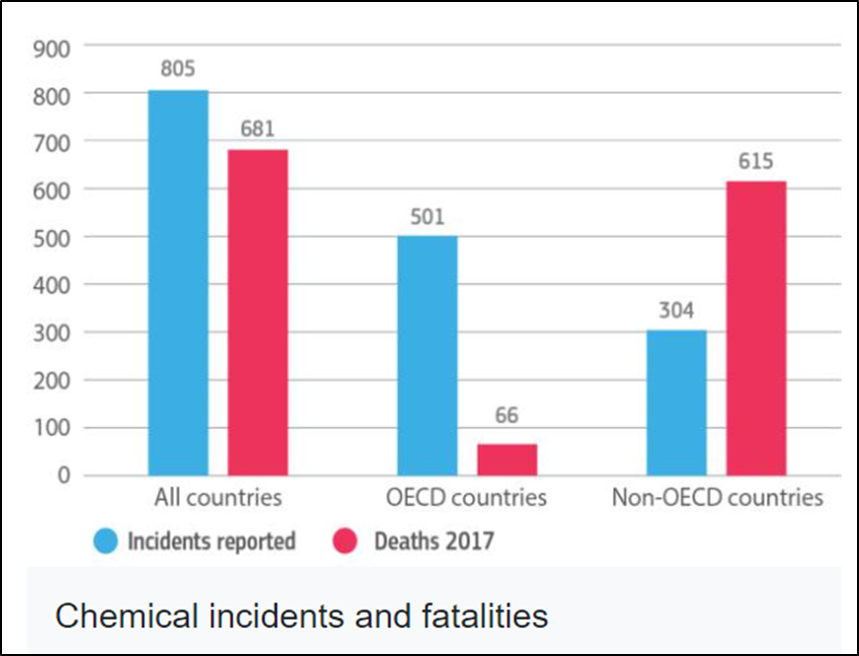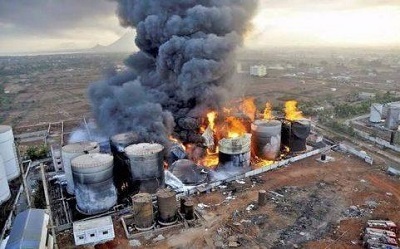Context-
A recent explosion of a reactor in a chemical factory in the Dombivli Maharashtra Industrial Development Corporation (MIDC) area resulted in the tragic loss of lives and injuries to workers and residents. This incident also caused significant damage to neighboring factories, shops, and residences. In response, the Maharashtra government announced compensation for the families of the deceased and funds for the treatment of the injured.
Historical Context of Industrial Accidents
Newspaper reports indicate that fatal industrial accidents have been frequent in 2016, 2018, 2020, and 2023.

Despite deciding in 2022 to relocate 156 chemical factories from the Dombivli MIDC area to Patalganga, the Maharashtra government failed to implement this decision. It was later revealed that the boiler in the chemical factory involved in the 2024 explosion was not registered under the Indian Boiler Regulations, 1950.
|
Defining Industrial Accident- An industrial accident is an event that disrupts the orderly progress of work in an industrial establishment. According to the Factories Act of 1948, it is an occurrence in an industrial setting that causes bodily injury, rendering a person unfit to resume duties within the next 48 hours. Essentially, it is a sudden, unexpected event that is neither anticipated nor planned. |
Inspection Shortcomings
- Poor Inspection Rates : In 2021, Maharashtra inspected only 1,551 of its 6,492 hazardous factories, resulting in a 23.89% inspection rate. Additionally, only 3,158 out of 39,255 registered factories were inspected, yielding an 8.04% inspection rate. This trend of inadequate inspections is mirrored in other leading industrial states. Tamil Nadu had a general inspection rate of 17.04% and a hazardous factories inspection rate of 25.39%. Gujarat showed similar figures with a general inspection rate of 19.33% and a hazardous factories inspection rate of 19.81%. The all-India figures for 2021 were 14.65% for general inspections and 26.02% for hazardous factories inspections, according to the Directorate General Factory Advice Service & Labour Institutes report, 2022.
- Staffing Issues : One reason for the poor inspection rates is a shortage of personnel. In Maharashtra, the appointment rate for inspectors was just 39.34%, with only 48 out of the 122 sanctioned officers in place. Gujarat had a slightly better appointment rate of 50.98%, and Tamil Nadu stood at 53.57%. The all-India figure for the appointment rate was 67.58%. Even the number of sanctioned posts relative to the number of registered factories has been insufficient to ensure annual inspections for every factory. In 2021, each of the 953 sanctioned inspectors at the all-India level would have had to inspect 337 registered factories annually.
- Heavy Workload : The heavy workload for inspectors further exacerbates the issue. In Maharashtra, each inspector was responsible for inspecting 818 factories per year; in Gujarat, 589; in Tamil Nadu, 532; and the all-India average was 499. This excessive workload severely limits the effectiveness and thoroughness of inspections.
- Low Prosecution Rates : The prosecution rate, defined as the number of prosecutions decided as a percentage of total prosecutions (including pending cases), was also low. In Gujarat, it was 6.95%; in Maharashtra, 13.84%; and in Tamil Nadu, 14.45%. Consequently, inspections lack their intended deterrent effect.
- Weak Labour Market Governance : The data clearly indicate that labour market governance through the labour inspection system is weak and inefficient. Despite this, employers often criticize the system as "inspector-raj," implying harassment and the prevalence of corrupt practices such as bribes.
The Need for Inspection Reforms
- Addressing Criticisms : The criticisms of the inspection system are not entirely unfounded. Given the extensive scope of inspections, inspectors may "target" and "harass" certain factories, exerting state power and potentially seeking bribes. However, this behavior is not universal, as evidenced by the statistics. In May 2024, the president of the Maharashtra Industry Development Association admitted in a media report that safety inspections and certifications were often conducted based on an "understanding" between auditors and factory owners or managers. This indicates that employers are as culpable as the labour inspectors, and addressing the "supply side" of corrupt practices is as crucial as reforming the "demand" side.
- Ineffective Reform Measures : Current reforms in the inspection system, often initiated in response to employer criticisms, have been inadequate. Measures such as self-certification, randomized inspections, online inspections, and third-party certification have been introduced by political parties at the national and state levels. However, these changes contravene several articles in the International Labour Organization’s Labour Inspection Convention (081), 1947. The Convention mandates sufficient qualified and well-provided inspectors who can enter establishments freely and without prior notice to ensure compliance with labour laws.
ILO Recommendations on Industrial Disaster Prevention
Identification of Hazardous Materials:
Inventory of Major Hazard Workplaces:
Centralised Data Management:
|
- Ensuring Strong Labour Market Governance : Rather than liberalizing the inspection system, governments should ensure robust labour market governance by adhering to the ILO Convention provisions. Given the rapid advancements in technology and the use of hazardous and chemical substances, the need for rigorous inspections has increased. Inspectors should be able to both "inspect" and "facilitate" compliance with laws by providing appropriate advice to employers and unions, as recognized by the ILO Convention.
- Accountability for Governance Failures : If firms or trade unions fail to comply with laws, they face prosecution by the state. However, when the state fails in its governance duties, the penalties are insufficient. Simple and meager compensation to victims and their families is inadequate. There must be a penal system for the enforcers as well, to ensure complete legal compliance. This would pave the way for a more effective and ethical labour inspectorate.
Key Regulations on Industrial Disaster Management
|
Conclusion
The recurrence of similar industrial disasters highlights the government’s failure to learn from past incidents. In the name of reforms and lean governance, the state cannot abdicate its fundamental duty to ensure a safe working and living environment. Meaningful reforms are needed to ensure an efficient and ethical labour inspection system that prioritizes the safety and well-being of workers and the community.
|
Probable questions for UPSC Mains Exam-
|
Source- The Hindu







